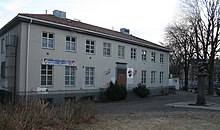Dælenenga idrettspark
The facilities are owned by the Municipality of Oslo and used and operated by Grüner IL, the local sports club.[8] In 1985, artificial ice was laid north of the football pitch, costing 2.1 million Norwegian krone (NOK).The club therefore hired Einar Dahle Arkitekter to work on a new design, resulting in area planning regulations being passed in 1991.[10] In 1994, the municipality initiated a redevelopment program of the downtown residential areas, which included grants to build Grünerhallen.[13] Dælenenga idrettspark consists of a club house, an artificial turf football pitch and an indoor ice rink.The venue is owned by Oslo Municipality, but the day-to-day operation is undertaken by Grüner IL, the main tenant.The building has suffered under lack of maintenance and has been subject to water damage, although the outer walls and foundation are in good condition.The club house has an impractical floor plan, and contains gyms for martial art and changing rooms for the pitch.[10] Dælenenga idrettspark is 1.5 kilometers (1 mi) from downtown Oslo and is located on Ruter bus route 30[16] and close to the light rail station Birkelunden on the Grünerløkka–Torshov Line.[17] During the late 1920s and 1930s, Dælenenga was dominated by the Workers' Sports Federation (AIF) and served as its main stadium in Oslo.The route ran through various streets in eastern Oslo and was a counter-measure to Holmenkollstafetten in the western part of town.The most notable regular local drivers were Basse Hveem, Henry Andersen, Werner Lorentzen and Aage Hansen.

GrünerhallenGrünerløkkaCoordinatesMunicipality of OsloArtificial turfGrüner ILSportsklubben av 1909Norwayfootball pitchice rinkathleticsspeed skatingmartial artsvelodromeWorkers' Sports Federationspeedwayeight ice hockey matchestwo bandy matches1952 Winter OlympicsArtificial iceJordal IdrettsparkwrestlingboxingSecond World Wardrug dealingNorwegian kronecredit crunchcost overrunsmartial artweight liftingBirkelundenGrünerløkka–Torshov LineMay Dayrelay racehandballWehrmachtThird DivisionFirst DivisionClas Thunbergworld records in 1,000 metersHans EngnestangenIce hockey at the 1952 Winter OlympicsBandy at the 1952 Winter OlympicsJordal AmfiSwedenFinlandCzechoslovakiaSwitzerlandPolandCanadaUnited StatesGermanydemonstration sportSpeedway World ChampionshipNorwegian Individual Speedway ChampionshipNorwegian Ministry of CultureAftenposten AftenGrüner HockeyNorwegian Ice Hockey AssociationFootball Association of NorwayDagsavisen1. divisjon (ice hockey)BergenGjøvikGrünerKongsvingerManglerud StarNidarosRingerike PanthersBergenshallenGjøvik Olympiske ishallKongshallenLeangen IshallManglerudhallen2015–162016–172017–182018–19EliteHockey Ligaen1. divisjon 2. divisjon2. divisjonNational men's teamNational women's teamNational men's junior teamNational women's U-18 teamNorwegian NHL drafteesIIHF Continental CupIIHF European Champions CupVenuesBislett StadiumHolmenkollbakkenHolmenkollen Ski StadiumKadettangenKorketrekkerenLillestrøm StadionMarienlyst StadionNorefjellRødkleivaOlympic venues in ice hockeyPalais de Glace d'AnversStade Olympique de ChamonixSt. Moritz Olympic Ice RinkOlympic ArenaOlympic StadiumOlympia-KunsteisstadionRiesserseeSuvrettaApollonio StadiumStadio Olimpico Del GhiaccioBlyth ArenaSquaw Valley Olympic Skating RinkMessehalleOlympiahalleLa Patinoire MunicipaleLe Stade de GlaceMakomanai Ice ArenaTsukisamu Indoor Skating RinkOlympic CenterSkenderija II HallZetra Ice HallFather David Bauer Olympic ArenaOlympic SaddledomeStampede CorralMéribel Ice PalaceGjøvik Olympic Cavern Hall